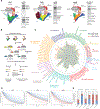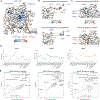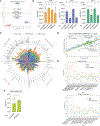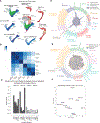Chromatin landscape signals differentially dictate the activities of mSWI/SNF family complexes
- PMID: 34437148
- PMCID: PMC8390793
- DOI: 10.1126/science.abf8705
Chromatin landscape signals differentially dictate the activities of mSWI/SNF family complexes
Abstract
Mammalian SWI/SNF (mSWI/SNF) adenosine triphosphate-dependent chromatin remodelers modulate genomic architecture and gene expression and are frequently mutated in disease. However, the specific chromatin features that govern their nucleosome binding and remodeling activities remain unknown. We subjected endogenously purified mSWI/SNF complexes and their constituent assembly modules to a diverse library of DNA-barcoded mononucleosomes, performing more than 25,000 binding and remodeling measurements. Here, we define histone modification-, variant-, and mutation-specific effects, alone and in combination, on mSWI/SNF activities and chromatin interactions. Further, we identify the combinatorial contributions of complex module components, reader domains, and nucleosome engagement properties to the localization of complexes to selectively permissive chromatin states. These findings uncover principles that shape the genomic binding and activity of a major chromatin remodeler complex family.
Copyright © 2021 The Authors, some rights reserved; exclusive licensee American Association for the Advancement of Science. No claim to original U.S. Government Works.
Conflict of interest statement
Figures




Comment in
-
Context-specific chromatin remodeling activity of mSWI/SNF complexes depends on the epigenetic landscape.Signal Transduct Target Ther. 2021 Oct 6;6(1):360. doi: 10.1038/s41392-021-00770-6. Signal Transduct Target Ther. 2021. PMID: 34615852 Free PMC article. No abstract available.
References
-
- Bates SE, Epigenetic Therapies for Cancer. The New England journal of medicine 383, 650–663 (2020). - PubMed
Publication types
MeSH terms
Substances
Grants and funding
LinkOut - more resources
Full Text Sources
Other Literature Sources

